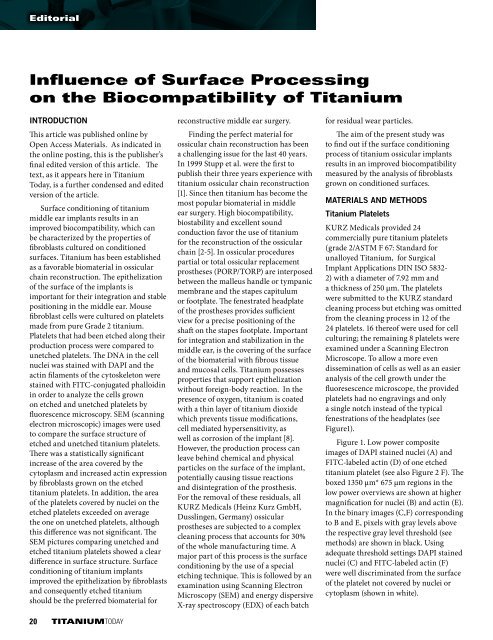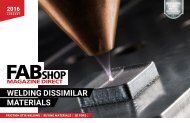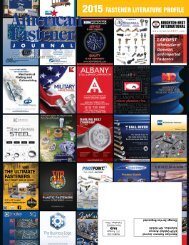100% Positive Material Identification
23mhiW2
23mhiW2
Create successful ePaper yourself
Turn your PDF publications into a flip-book with our unique Google optimized e-Paper software.
Editorial<br />
Influence of Surface Processing<br />
on the Biocompatibility of Titanium<br />
INTRODUCTION<br />
This article was published online by<br />
Open Access <strong>Material</strong>s. As indicated in<br />
the online posting, this is the publisher’s<br />
final edited version of this article. The<br />
text, as it appears here in Titanium<br />
Today, is a further condensed and edited<br />
version of the article.<br />
Surface conditioning of titanium<br />
middle ear implants results in an<br />
improved biocompatibility, which can<br />
be characterized by the properties of<br />
fibroblasts cultured on conditioned<br />
surfaces. Titanium has been established<br />
as a favorable biomaterial in ossicular<br />
chain reconstruction. The epithelization<br />
of the surface of the implants is<br />
important for their integration and stable<br />
positioning in the middle ear. Mouse<br />
fibroblast cells were cultured on platelets<br />
made from pure Grade 2 titanium.<br />
Platelets that had been etched along their<br />
production process were compared to<br />
unetched platelets. The DNA in the cell<br />
nuclei was stained with DAPI and the<br />
actin filaments of the cytoskeleton were<br />
stained with FITC-conjugated phalloidin<br />
in order to analyze the cells grown<br />
on etched and unetched platelets by<br />
fluorescence microscopy. SEM (scanning<br />
electron microscopic) images were used<br />
to compare the surface structure of<br />
etched and unetched titanium platelets.<br />
There was a statistically significant<br />
increase of the area covered by the<br />
cytoplasm and increased actin expression<br />
by fibroblasts grown on the etched<br />
titanium platelets. In addition, the area<br />
of the platelets covered by nuclei on the<br />
etched platelets exceeded on average<br />
the one on unetched platelets, although<br />
this difference was not significant. The<br />
SEM pictures comparing unetched and<br />
etched titanium platelets showed a clear<br />
difference in surface structure. Surface<br />
conditioning of titanium implants<br />
improved the epithelization by fibroblasts<br />
and consequently etched titanium<br />
should be the preferred biomaterial for<br />
20 TITANIUMTODAY<br />
reconstructive middle ear surgery.<br />
Finding the perfect material for<br />
ossicular chain reconstruction has been<br />
a challenging issue for the last 40 years.<br />
In 1999 Stupp et al. were the first to<br />
publish their three years experience with<br />
titanium ossicular chain reconstruction<br />
[1]. Since then titanium has become the<br />
most popular biomaterial in middle<br />
ear surgery. High biocompatibility,<br />
biostability and excellent sound<br />
conduction favor the use of titanium<br />
for the reconstruction of the ossicular<br />
chain [2-5]. In ossicular procedures<br />
partial or total ossicular replacement<br />
prostheses (PORP/TORP) are interposed<br />
between the malleus handle or tympanic<br />
membrane and the stapes capitulum<br />
or footplate. The fenestrated headplate<br />
of the prostheses provides sufficient<br />
view for a precise positioning of the<br />
shaft on the stapes footplate. Important<br />
for integration and stabilization in the<br />
middle ear, is the covering of the surface<br />
of the biomaterial with fibrous tissue<br />
and mucosal cells. Titanium possesses<br />
properties that support epithelization<br />
without foreign-body reaction. In the<br />
presence of oxygen, titanium is coated<br />
with a thin layer of titanium dioxide<br />
which prevents tissue modifications,<br />
cell mediated hypersensitivity, as<br />
well as corrosion of the implant [8].<br />
However, the production process can<br />
leave behind chemical and physical<br />
particles on the surface of the implant,<br />
potentially causing tissue reactions<br />
and disintegration of the prosthesis.<br />
For the removal of these residuals, all<br />
KURZ Medicals (Heinz Kurz GmbH,<br />
Dusslingen, Germany) ossicular<br />
prostheses are subjected to a complex<br />
cleaning process that accounts for 30%<br />
of the whole manufacturing time. A<br />
major part of this process is the surface<br />
conditioning by the use of a special<br />
etching technique. This is followed by an<br />
examination using Scanning Electron<br />
Microscopy (SEM) and energy dispersive<br />
X-ray spectroscopy (EDX) of each batch<br />
for residual wear particles.<br />
The aim of the present study was<br />
to find out if the surface conditioning<br />
process of titanium ossicular implants<br />
results in an improved biocompatibility<br />
measured by the analysis of fibroblasts<br />
grown on conditioned surfaces.<br />
MATERIALS AND METHODS<br />
Titanium Platelets<br />
KURZ Medicals provided 24<br />
commercially pure titanium platelets<br />
(grade 2/ASTM F 67: Standard for<br />
unalloyed Titanium, for Surgical<br />
Implant Applications DIN ISO 5832-<br />
2) with a diameter of 7.92 mm and<br />
a thickness of 250 µm. The platelets<br />
were submitted to the KURZ standard<br />
cleaning process but etching was omitted<br />
from the cleaning process in 12 of the<br />
24 platelets. 16 thereof were used for cell<br />
culturing; the remaining 8 platelets were<br />
examined under a Scanning Electron<br />
Microscope. To allow a more even<br />
dissemination of cells as well as an easier<br />
analysis of the cell growth under the<br />
fluoresescence microscope, the provided<br />
platelets had no engravings and only<br />
a single notch instead of the typical<br />
fenestrations of the headplates (see<br />
Figure1).<br />
Figure 1. Low power composite<br />
images of DAPI stained nuclei (A) and<br />
FITC-labeled actin (D) of one etched<br />
titanium platelet (see also Figure 2 F). The<br />
boxed 1350 µm* 675 µm regions in the<br />
low power overviews are shown at higher<br />
magnification for nuclei (B) and actin (E).<br />
In the binary images (C,F) corresponding<br />
to B and E, pixels with gray levels above<br />
the respective gray level threshold (see<br />
methods) are shown in black. Using<br />
adequate threshold settings DAPI stained<br />
nuclei (C) and FITC-labeled actin (F)<br />
were well discriminated from the surface<br />
of the platelet not covered by nuclei or<br />
cytoplasm (shown in white).







